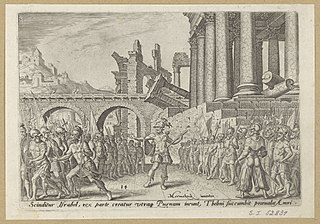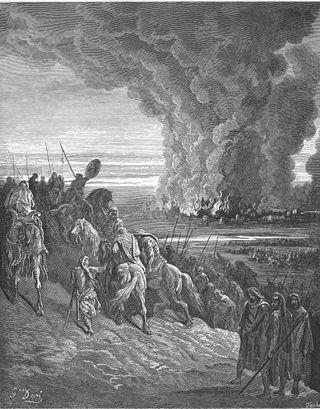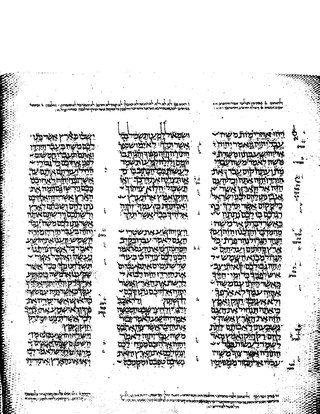Related Research Articles

Joshua also known as Yehoshua or Josue, functioned as Moses' assistant in the books of Exodus and Numbers, and later succeeded Moses as leader of the Israelite tribes in the Book of Joshua of the Hebrew Bible. His name was Hoshea the son of Nun, of the tribe of Ephraim, but Moses called him "Yehoshua", the name by which he is commonly known in English. According to the Bible, he was born in Egypt prior to the Exodus.

Omri was, according to the Hebrew Bible, the sixth king of Israel. He was a successful military campaigner who extended the northern kingdom of Israel. Other monarchs from the House of Omri are Ahab, Ahaziah, Joram, and Athaliah. Like his predecessor, king Zimri, who ruled for only seven days, Omri is the second king mentioned in the Bible without a statement of his tribal origin. One possibility, though unproven, is that he was of the tribe of Issachar.
Ebez also rendered Abez, was a town in the allotment of the tribe of Issachar, at the north of the Jezreel Valley, or plain of Esdraelon. F. R. and C. R. Conder (1879), believed that it was probably the ruins of el-Beida, but William Robertson Smith (1899) expressed doubt about this identification. According to the 1915 International Standard Bible Encyclopedia (1915), the location is not known. It is mentioned only in Joshua 19:20, where various manuscripts of the Septuagint render it as Rebes, Aeme, or Aemis. It is mentioned on the façade of the Mortuary Temple of Ramesses III at Medinet Habu as Apijaa.
Achor is the name of a valley in the vicinity of Jericho.
According to the Bible, Admah was one of the five cities of the Vale of Siddim. It was destroyed along with Sodom and Gomorrah. It is supposed by William F. Albright to be the same as the "Adam" of Joshua 3:16. The location of Admah is unknown, although Bryant G. Wood a proponent of the southern theory for the Cities of the Plain identified the site with Numeira, but later changed it to Khirbat al-Khanazir Jordan, although it was only a cemetery during the Bronze Age and proponents of the northern theory for the Cities of the Plain identify the site with Tel Nimrin, Jordan.
Zaretan or Zarethan, also known as Zeredathah, is a city mentioned in the Hebrew Bible as near the location where the Hebrews crossed the Jordan. In the books of Joshua and 1 Kings, it is called Zarethan, but in 2 Chronicles it is called Zeredathah.

Shunaam was a small village mentioned in the Bible in the possession of the Tribe of Issachar. It was located near the Jezreel Valley, north of Mount Gilboa. Shunaam is where the Philistines camped when they fought Saul, the first king of Israel. It was the hometown of Abishag, King David's companion in his old age. The prophet Elisha was hospitably entertained there by a wealthy woman whose deceased son Elisha brought back to life.

According to the Hebrew Bible, the Tribe of Manasseh was one of the Tribes of Israel. It is one of the ten lost tribes. Together with the Tribe of Ephraim, Manasseh also formed the House of Joseph.

Tibni was a claimant to the throne of Israel and the son of Ginath. Albright has dated his reign to 876–871 BC, while Thiele offers the dates 885–880 BC.
Gilgal, also known as Galgala or Galgalatokai of the 12 Stones, is the name of one or more places in the Hebrew Bible. Gilgal is mentioned 39 times, in particular in the Book of Joshua, as the place where the Israelites camped after crossing the Jordan River. The Hebrew term Gilgal most likely means "circle of stones". Its name appears in Koine Greek on the Madaba Map.

Gibeah is the name of three places mentioned in the Hebrew Bible, in the tribes of Benjamin, Judah, and Ephraim respectively.

The Ai was a Canaanite city. According to the Book of Joshua in the Hebrew Bible, it was conquered by the Israelites on their second attempt. The ruins of the city are popularly thought to be in the modern-day archeological site Et-Tell.

The Twelve Tribes of Israel are, according to Hebrew scriptures, the descendants of the biblical patriarch Jacob, also known as Israel, through his twelve sons through his wives, Leah and Rachel, and his concubines, Bilhah and Zilpah, who collectively form the Israelite nation. In modern scholarship, there is skepticism as to whether there ever were twelve Israelite tribes, with the use of the number 12 thought more likely to signify a symbolic tradition as part of a national founding myth.
Kabzeel is a Hebrew Bible place name. It was the most remote city of Judah; located in southern Judah on the border of Edom (Idumaea). The location is tentatively identified with Khirbet Hora, about 10 km ENE of Beer-sheba. Kabzeel was the birthplace of Benaiah, one of David's chief warriors. Following the Exile, it was resettled under the name Jekabzeel.
Ataroth is the name of two or three Iron Age cities mentioned in the Hebrew Bible and the Mesha Stele.

Joshua 19 is the nineteenth chapter of the Book of Joshua in the Hebrew Bible or in the Old Testament of the Christian Bible. According to Jewish tradition the book was attributed to the Joshua, with additions by the high priests Eleazar and Phinehas, but modern scholars view it as part of the Deuteronomistic History, which spans the books of Deuteronomy to 2 Kings, attributed to nationalistic and devotedly Yahwistic writers during the time of the reformer Judean king Josiah in the 7th century BCE. This chapter records the further allotment of land for the tribes of Israel, especially the tribes of Simeon, Zebulun, Issachar, Asher, Naphtali and Dan, as well as Joshua's Inheritance, a part of a section comprising Joshua 13:1–21:45 about the Israelites allotting the land of Canaan.

According to the Hebrew Bible, the Tribe of Zebulun was one of the twelve tribes of Israel.

The Tribe of Naphtali was one of the northernmost of the twelve tribes of Israel. It is one of the ten lost tribes.
References
- ↑ Joshua 19:21 and 21:29
- 1 2 J. D. Douglas; Merrill C. Tenney (3 May 2011). Zondervan Illustrated Bible Dictionary. Harper Collins. p. 67. ISBN 978-0-310-49235-1.
- ↑ William F. Albright (1926). "The Topography of the Tribe of Issachar". In Zeitschrift für die alttestamentliche Wissenschaft. p. 231.
- ↑ e.g., Martino (Ed.). Atlas Biblicus. Continens Duas Et Viginti Tabulas Quibus Accedit. Index topographicus in Universam Geographam Biblicam, Paris (Suptibus P. Lethielleux, 1907). Quote: "urbs tribus Issachar, fortasse eadem atque Engannim (Djenin) vel probabilius urbs distincta, vicus ‘Anim inter aquilonem et occidentum ab Engannim.
![]() This article incorporates text from a publication now in the public domain : Easton, Matthew George (1897). "Anem". Easton's Bible Dictionary (New and revised ed.). T. Nelson and Sons.
This article incorporates text from a publication now in the public domain : Easton, Matthew George (1897). "Anem". Easton's Bible Dictionary (New and revised ed.). T. Nelson and Sons.